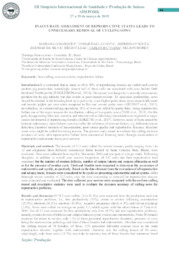Inaccurate assessment of reproductive status leads to unnecessary removal of cycling sows.
Inaccurate assessment of reproductive status leads to unnecessary removal of cycling sows.
Author(s): MARQUES, M. G.; DALLA COSTA, O. A.; SOUZA, A. P.; SILVA, Z. da; LEAL, D. F.; VIANA, C. H. C.; MORÉS, N.
Summary: It is estimated that as many as 40 to 50% of reproducing females are culled each year in modern pig production; astonishgly, almost half of these culls are associated with sows before their third and fourth parity (ENGLEBON et al., 2016). Decreased sow longevity is not only an economic problem for the pig industry but also results in poor animal welfare. To maximize profitability, sows should be retained in the breeding herd up to parity six, since higher parity dams wean numerically more and heavier piglets per year when compared to first and second parity sows (GRUHOT et al., 2017); nevertheless, in commercial pig operations 30% of sows are culled by parity three, being reproductive failure one of the major reasons for involuntary culling of low parity sows (TANI et al., 2018). On this path, disappointing litter size, anestrus and return to estrus following insemination are regarded as major causes for removal of reproducing females (KOKETSU et al., 2017). However, aside of been caused by intrinsic unbalances, these failures can also suffer the influence of external factors, e.g. deficient estrous detection, incorrect moment of insemination, poor semen quality and reproductive diseases, therefore some sows might be culled for wrong reasons. The present study aimed to evaluate the culling decision accuracy of sows with reproductive failure from commercial breeding herds through examination of reproductive and urinary tracts post mortem.
Publication year: 2019
Types of publication: Paper in annals and proceedings
Unit: Embrapa Swine & Poultry
Keywords: Abate, Falha na reprodução, Fêmeas reprodutivas, Porca, Reprodução Animal, Suinocultura
Observation
Some of Embrapa's publications are published as ePub files. To read them, use or download one of the following free software options to your computer or mobile device. Android: Google Play Books; IOS: iBooks; Windows and Linux: Calibre.
Access other publications
Access the Agricultural Research Database (BDPA) to consult Embrapa's full library collection and records.
Visit Embrapa Bookstore to purchase books and other publications sold by Embrapa.

